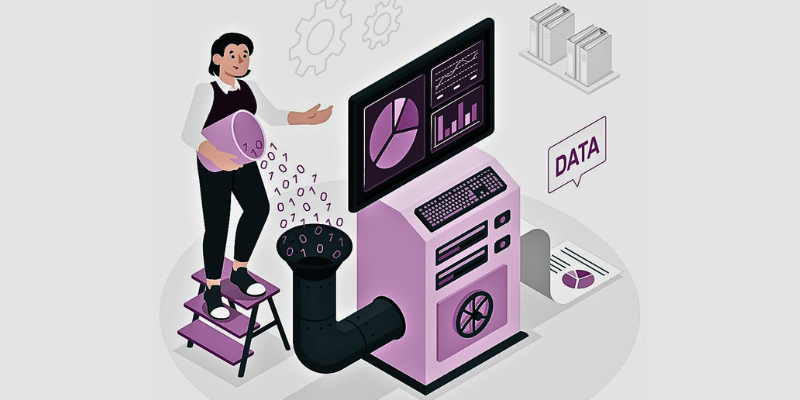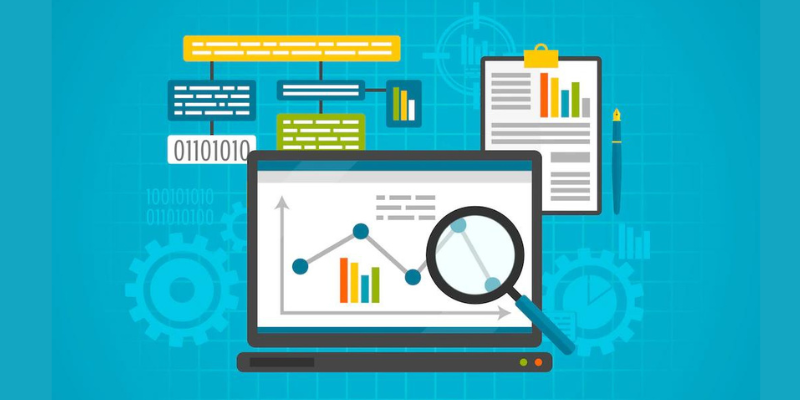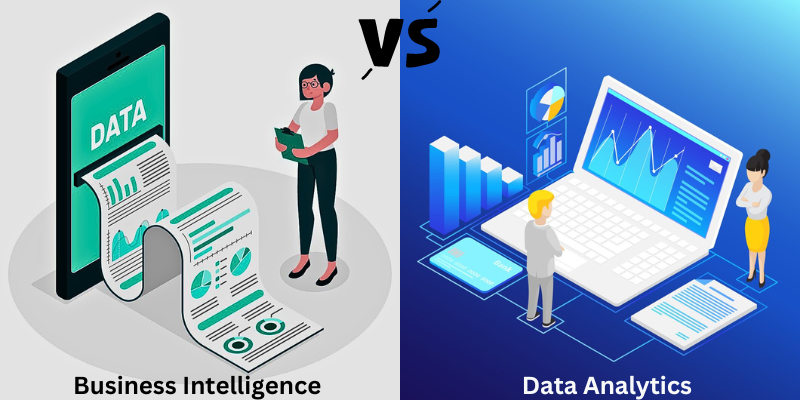Business intelligence and data analytics are two vital techniques that modern businesses leverage to gain valuable, accurate business insights.
Both these methods help visualize, analyze, and understand data related to your business, customers, competitors, and the industry you belong to.
This can help you make better business decisions, craft fruitful strategies, improve your operations, obtain better sales and revenue, find patterns, and predict future moves.
Although business intelligence and data analytics both play crucial roles and might be used interchangeably in various areas, these terms mean different for different industries.
Both have different requirements and scopes of work. They need varying skills to help companies flourish with better decision-making with the help of data-driven results obtained with these techniques.
Therefore, making the right choice between the two is tough for companies.
In this article, I’ll discuss business intelligence and data analytics and the differences between them based on their types, goals, benefits, limitations, and applications to help you choose the right method for your organization.
Let’s start!
What Is Business Intelligence?
Business intelligence (BI) is a process where collecting and storing present and past data happens in order to analyze this data and make technology-driven business decisions from it. This will improve your business operations as well as the profit margin.

BI combines different methodologies like data mining, business analytics, data tools, data visualization, company best practices, and infrastructure. Thus, it can offer quick-to-use data summaries that allow your business to move forward in today’s data-driven world.
In addition, BI can help unlock your marketing and sales potential and innovate new business capabilities.
Furthermore, business intelligence helps organizations adapt to new market strategies, drive beneficial changes, and eliminate inefficiencies. It enables businesses to know about the latest trends and access robust data analysis capabilities.
Furthermore, you can use this method to achieve many things, such as faster issue resolution, business growth, and prediction of future outcomes.
Goal: The primary goal of business intelligence is to filter essential business information and carry forward an analysis of the given information over a particular time frame. And you need business intelligence tools to do these tedious tasks. They will help you achieve higher market efficiency so you can stay ahead of the competition.
Thus, rather than using your gut feelings and assumptions, you can make perfect business decisions with accurate historical data. It performs data analysis to create summaries, reports, maps, graphs, dashboards, and charts so that users can know the true nature of your business.
Business intelligence can deal with large amounts of unstructured and structured data that help identify and develop new strategies to gather several business opportunities.
What Is Data Analytics?

Data analytics (DA) is a process or strategy of collecting, inspecting, cleaning, storing, transforming, querying, and modeling data. The primary goal is to generate insights that can help organizations make informed business decisions.
It seems similar to business intelligence. However, data analytics can be a part of BI that primarily focuses on the analytics process only.
Although data analytics is used often in a business, it is not an intelligence tool. In contrast, Data analytics is a strategy used in the technical process of managing data, from mining to transforming. It takes a large volume of data in order to find current trends and solve bigger issues within a matter of time.
In other words, data analytics involves machines or humans finding, interpreting, visualizing, and identifying the patterns in the data. It can help you find:
- Trends
- Anomalies
- Outliers
- Opportunities
- Risks
Data analytics is used by businesses and other fields to make accurate and better data-driven decisions in order to predict future business growth. The processes and techniques used in data analytics are automated with emerging technologies like Artificial Intelligence (AI) algorithms.
Thus, businesses with a competitive target in the market used data analytics to sustain and grow their customer base. In general, it uses computational and statistical techniques to find relationships, patterns, and trends within data sets. In addition, it uses special techniques and technologies, such as data visualization software, Big Data platforms, ML algorithms, etc.
Business Intelligence vs. Data Analytics: Types
Types of Business Intelligence

There are two main categories of BI – Traditional BI and Modern BI.
Traditional business intelligence: In traditional BI, you will find structured data from businesses’ internal sources, such as finance, sales, and inventory data. These types of data are collected and stored in data warehouses to further analyze it using SQL-based tools, including dashboards, reporting, and OLAP cubes.
Examples: Sales analysis, operational performance analysis, and financial reporting.
Modern business intelligence: In this category, BI utilizes the latest technologies to offer self-service and real-time access to numerous data from a wide range of sources. It allows you to explore, identify, and analyze data easily through visualizations, dashboards, and NLP.
In addition, it incorporates ML algorithms to automate data discovery, analysis, and preparation, making it smoother and easier to gain insights.
Examples: Data discovery, real-time reporting, predictive analytics, self-service analytics, and more.
Types of Data Analytics

There are four different types of data analytics; each has a different approach and focus.
Descriptive analytics: This involves historical data analytics that helps your business gain insights into past data. It summarizes these past data into KPIs so that you can understand your business performance.
Examples: Website traffic analysis, customer satisfaction scores, sales reports, etc.
Diagnostic analytics: This analyzes past data to understand “why”, like why sales reports were down in the past. It detects the root cause and investigates the issue by analyzing relationships and patterns within the data.
Examples: Customer churn analysis, employee turnover analysis, and product defect analysis.
Predictive analytics: In this analytics, you can use ML algorithms and statistical models to make predictions on future outcomes using historical data. This allows businesses to identify opportunities and potential risks before they occur.
Examples: Prediction on customer lifetime value, demand forecasting, and fraud detection.
Prescriptive analytics: This is a kind of analytics where you use insights and data to provide essential suggestions so that needed actions could be taken in order to get a defined goal. It allows you to make decisions with the help of actionable insights.
Examples: Pricing optimization, marketing campaign optimization, and supply chain optimization.
By utilizing the above analytics, businesses make informed decisions, enhance their operations, and gain a perfect market edge.
Business Intelligence vs Data Analytics: Features
Features of Business Intelligence

Some important features of BI include:
- Advanced analytics: It helps you perform complicated data manipulation. This enables regression analysis so that you can analyze connections between independent and dependent variables.
- Reporting: You can build and distribute reports without IT assistance. Also, you can schedule it to ensure the automatic delivery of reports at recurring times.
- Data visualization: This lets you present complicated data in simpler formats. BI tools can create sophisticated and advanced visualizations that easily convey data.
- Geospatial analysis: With the geographic map functionality, you can easily find locations in the map view. BI tools take your data and convert it into cartographic and graphical representations so that you can easily view geographical data.
- Data management: It involves blending, exploring, cleaning, and preparing data for analysis. It combines different data sets to build a new one. This also helps explore information to uncover recent trends, characteristics, points of interest, and patterns.
Other features of business intelligence are augmented analysis, predictive analysis, user-specific security, self-service analytics, and data integration.
Features of Data Analytics

Some of its crucial features are.
- Data preparation and wrangling: The idea of this process is to conduct data preparation procedures once during the ongoing project. This helps prepare an iterative model for the same project if needed. Data wrangling is carried out during model construction and iterative analysis to eliminate errors and combine complex data to ease analysis and accessibility.
- Data exploration: This is the initial stage of analyzing data is data exploration. It involves the visualization of data to gain insights into several patterns or regions that need further identification.
- Scalability: To vertically scale up or down a system, a faster server, along with memory and powerful processors, is needed. This utilizes less energy and network gear and is the only temporary cure for data analytics platforms.
- Version control: It is a source control or the process of maintaining track and controlling software code changes.
- Data security: This feature is useful in preventing data from unauthorized access or being stolen or corrupted at any point. It encompasses logical program security, storage device security, physical hardware security, and more.
Business Intelligence vs Data Analytics: Components
Components of Business Intelligence

Business intelligence has five components:
- OLAP: Online Analytical Processing (OLAP) helps business executives sort and select aggregated data and monitor it strategically.
- Advanced analytics: This component of BI helps get the statistics of a particular product and service. It allows you to predict the product performance in the market.
- Data warehousing: This involves storing enormous data to benefit the multiple divisions of an enterprise.
- Real-time BI: This helps keep track of changing marketing trends. With this component, the marketing team can announce special discounts and offers to grab customer attention and engagement engage on the website.
- Data sources: It involves taking raw information and creating data sources systematically using several applications. BI tools use these datasets to build graphs, tables, and pie charts.
Components of Data Analytics

There are five components of data analytics:
- Data collection: This is the first stage of data analytics that involves collecting data both internally and externally for your business. The data comes from many sources, such as operational systems, web, and social media data, transaction data, machine data, etc.
- Data analyzing: Once data is collected, it needs to be analyzed. This is a process where you can use statistical techniques to clean and examine the data in order to gather useful information. Data analysis helps identify patterns, predict the future, and detect anomalies.
- Reporting results: In this component, you can share insights and make informed decisions based on your findings. The common methods used to report results include presenting the findings in a dashboard, generating reports, and creating infographics.
- Improving processes: This involves changing the way data is gathered, processed, and analyzed. It also changes the decision makings ways based on the data.
- Data-driven culture: You can create a culture where everyone can use data to make effective decisions. This helps train employees on data analytics usage and gives them access to resources. To build a data-driven culture, you need to follow some tips:
- Make the data accessible
- Train employees on data usage
- Encourage data-driven culture
- Create an accountability culture
Business Intelligence vs Data Analytics: Applications

Applications of Business Intelligence
Business intelligence can be implemented in several industries, such as:
- Retailing: BI is used to forecast customer demand and analyze demand fluctuations over time. This helps optimize the inventory size to meet customer demands.
- Banking: BI helps financial institutions, and banks identify their customer base. This allows them to plan their marketing strategies. Banks can also view their performance metrics with the help of Business Intelligence.
- Automobile: BI helps optimize the production, HR, marketing, research, distribution, and finance functions of the automobile industry. This is done to enable effective decision-making.
- Manufacturing: BI enhances communications with the suppliers and standardizes the transactions. It can forecast the product demand that will further optimize the inventory, procurement, and production size.
Other applications of BI are in hospitality, pharmaceutical services, FMCG, airways, distribution and logistics, and more.
Applications of Data Analytics
Some applications of data analytics are:
- Transportation: Data analytics can be used to solve traffic problems and enhance the travel experience by improving transportation intelligence and systems.
- Education: Policymakers use this technology to increase management decisions and learning curriculums.
- Marketing and advertising: Marketers and advertisers use data analytics to know their audience and get better conversion rates.
- Logistics and delivery: Data analytics can be used for better delivery processes and productive workflow in the logistics industry. This helps enhance industry performance and increase your customer base.
Other applications of data analytics are online security, internet web search results, fraud detection, and more.
Business Intelligence vs. Data Analytics: Quick Comparison

| Parameters | Business Intelligence | Data Analytics |
| Scope | BI refers to the data required to improve business decision-making. | Data analytics allows in transforming raw data into an understandable format that’s used for analysis and predicting the future. |
| Functionality | The primary goal of BI is to offer support to businesses in making informed decisions, creating better strategies, and helping them grow. | The primary goal is to model, predict, cleanse, and transform the data according to your business needs. |
| Implementation | BI is implemented using several BI tools. It can be only implemented using the past data stored in data marts or data warehouses. | Data analytics is implemented using multiple data storage tools. It depends on the strategy and approach designed by the company while implementing. |
| Debugging methods | It can be debugged using a proposed model that converts data into a meaningful format. | BI tools let you use the technology without proper coding knowledge. Many tools offer drag-and-drop interfaces to visualize and build dashboards. |
| Code | Data analytics involves programming language used to carry out complex analyses. Programming languages like R or Python are mandatory. | You can be a BI professional without core knowledge of probability and linear algebra. |
| Math | You can be BI professional without core knowledge of probability and linear algebra. | Data warehouse is mandatory since it transforms data to enhance the quality of data. |
| Statistics | BI involves descriptive statistics, including mean, median, and average. | Data analytics involves inferential and descriptive statistics to understand data in a better way and find valuable insights. |
| Data type | BI is carried out only on structured data curated for analyzing business data. | Data analytics has no limit. Analysts can carry forward the analysis process with audio, text, and video formats. |
| Data quality | Reports are executed at a particular time based on the use cases of your business. | It doesn’t depend on data warehouses to analyze data. |
| Reports | Reports are executed at a particular time based on use cases of your business. | Data analytics is flexible and is used for different use cases. |
Conclusion
Business intelligence and data analytics are two similar concepts but with different approaches. Considering the recent market trends, there is increasing usage of techniques like business intelligence and data analytics to gain actionable insights and improve business.
Data analytics helps enhance business efficiency and operations with useful insights taken by analyzing the aggregated data. On the other hand, BI helps make the best use of data in order to make fact-based, solid business decisions.
Thus, choosing one between them is a complicated task. It’s best to choose one of them or both based on your business requirements, operations, scenarios, and use cases.
You may also explore the best business intelligence and analytics platforms
Si quiere puede hacernos una donación por el trabajo que hacemos, lo apreciaremos mucho.
Direcciones de Billetera:
- BTC: 14xsuQRtT3Abek4zgDWZxJXs9VRdwxyPUS
- USDT: TQmV9FyrcpeaZMro3M1yeEHnNjv7xKZDNe
- BNB: 0x2fdb9034507b6d505d351a6f59d877040d0edb0f
- DOGE: D5SZesmFQGYVkE5trYYLF8hNPBgXgYcmrx
También puede seguirnos en nuestras Redes sociales para mantenerse al tanto de los últimos post de la web:
- Telegram
Disclaimer: En Cryptoshitcompra.com no nos hacemos responsables de ninguna inversión de ningún visitante, nosotros simplemente damos información sobre Tokens, juegos NFT y criptomonedas, no recomendamos inversiones


